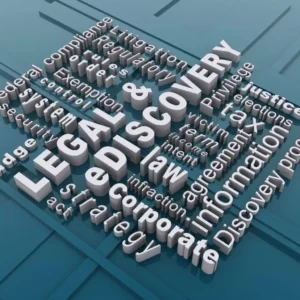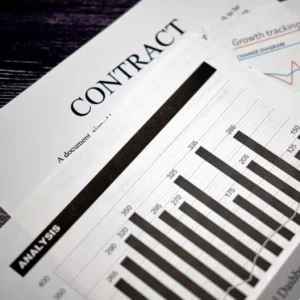
AI-Driven Legal Research
How Technology is Reshaping the Future of Law
The legal profession, known for its reverence for tradition, stands on the brink of a technological revolution. At its heart lies AI-driven legal research.
AI brings clarity in a domain where vast databases reign and legal jargon often seems impenetrable. With tools that harness natural language processing for understanding intricate laws to predictive models that give a sneak peek into potential case outcomes, AI promises a seismic shift.
This article promises a comprehensive voyage through this changing landscape. We’ll delve into the depths of AI-enhanced legal citation tools, understand the critical role of AI in paralegal tasks, and contemplate the future horizons of legal research.
But, as with all great leaps, there are ethical quandaries. Join us as we unravel the tapestry of AI’s profound impact on the legal sector.
Table of Contents
Navigating vast databases efficiently
The sheer volume of cases, statutes, and legal opinions can be overwhelming in law. Traditionally, legal professionals would spend countless hours sifting through archives and databases to find pertinent information. Enter AI-driven legal research. In seconds, these advanced platforms can search, analyze, and retrieve relevant data from vast databases. How?
AI-driven legal databases are the backbone, using sophisticated algorithms to search and present the most relevant cases. With natural language processing in legal research, these platforms can understand complex queries, making it easier for professionals to ask questions in everyday language. Moreover, machine learning for case relevance ensures that the results improve over time, adapting to user needs.
Beyond mere searching, AI for legal precedent discovery allows attorneys to uncover past rulings that can influence current cases. By leveraging AI-enhanced legal citation tools, these platforms ensure that every patient, statute, or legal document referenced is accurate and up-to-date.
However, with the rising influence of AI, one must ask: Are we trading depth for speed? While AI can churn results swiftly, is there a risk of overlooking nuanced details that traditional research might uncover? How do we strike the right balance?
Anticipating case rulings
One of the most potent game-changers introduced by AI-driven legal research is its potential to predict case outcomes. This doesn’t mean turning the legal profession into a guessing game but equipping lawyers with tools to better gauge their case strategies.
Are you curious about how AI can help legal professionals make informed decisions? With access to historical case data, AI platforms use advanced predictive analytics to detect patterns in case outcomes. This technology can provide valuable insights to support legal strategies and achieve favourable results.
Was a similar case ruled in favour of the defendant in the past? Are there recurring themes or arguments that tend to succeed in certain jurisdictions? This deep dive into precedent isn’t just about data—it’s about insight.
Then, there’s the power of natural language processing in legal research. With it, lawyers can pose hypothetical scenarios to AI systems and receive feedback based on past rulings. It refines the art of AI for legal precedent discovery by extracting more than just rulings—it draws out the very essence of each verdict.
Yet, the advantages of machine learning for case relevance can’t be understated. These algorithms can better curate relevant precedents, rulings, and citations by understanding user preferences and the case specifics.
But with these advancements, an intriguing question emerges: If lawyers can predict outcomes with increasing accuracy, will it change the nature of litigation itself? How might this shift the dynamics of the courtroom?
Uncovering relevant precedents
In the legal world, history often speaks louder than words. Precedents—past rulings and decisions—serve as beacons, guiding new cases to just resolutions. Historically, finding the right precedent was a needle-in-the-haystack exercise. However, AI-driven legal research is revolutionizing this aspect of the legal profession.
Central to this revolution are AI-driven legal databases, vast repositories containing case information. When paired with natural language processing in legal research, these databases become incredibly efficient at comprehending user queries, no matter how intricate. They don’t just search for keywords; they understand the context.
As machine learning for case relevance evolves, these tools refine their search capabilities. They don’t just provide cases that might be relevant; they pinpoint the ones that are most pertinent, taking into consideration the nuances of the ongoing case. AI further enhances this precision for legal precedent discovery, which seeks out not just cases but the very facets of those cases that could turn the tide in a legal battle.
Legal citation tools powered by AI are revolutionizing how we reference legal precedents. But here’s the question: with machines doing most of the heavy lifting, what happens to the gut instincts of seasoned attorneys? Will the collaboration between humans and machines define the future of legal expertise? Let’s explore the possibilities of this exciting synergy.
Comprehending legal languages and jargon
The intricacies of legal language can be daunting, even for seasoned professionals. Legal jargon, a mosaic of terms, phrases, and Latin expressions, often leaves many needing clarification. But in the age of AI-driven legal research, such complexities are being rapidly demystified.
The prowess of natural language processing in legal research has proved invaluable. Instead of merely scanning for keywords, these AI systems grasp legal texts’ nuances, context, and underlying meaning. They’re not just reading—they’re comprehending.
Such advancements, combined with machine learning for case relevance, ensure that the search results obtained from AI-driven legal databases are not only relevant but also deciphered in a manner that’s easy for users to understand. This nuanced understanding accelerates AI for legal precedent discovery, making extracting relevant precedents from complex legal documents a breeze.
Furthermore, with AI-enhanced legal citation tools, legal professionals can easily cross-reference jargon-heavy citations, ensuring clarity and accuracy in their work.
Yet, as AI continues to break down these linguistic barriers, it stirs curiosity: Will the next generation of lawyers be less adept at classical legal language? And how might this shift the landscape of legal education and training?
Citing accurately and promptly
In the meticulous world of legal proceedings, accurate citation isn’t just a mere formality—it’s pivotal. A single oversight in citing can undermine a case’s integrity. Yet, with the rise of AI-driven legal research, the dynamics of legal citation are experiencing a dramatic shift.
Modern AI-driven legal databases are well-equipped to locate relevant case references and present them with impeccable accuracy. Have you ever spent countless hours poring over legal documents only to realize you missed a crucial citation?
Well, those days are long gone! With the help of technology, you can now ensure accurate and error-free sources in no time. No more pulling your hair out to catch every detail – let the machines handle it! Now, AI-enhanced legal citation tools do the heavy lifting, and they do it promptly.
The capabilities of natural language processing complement this newfound efficiency in legal research. Instead of just recognizing a case name or statute number, these systems understand the broader context, ensuring that citations are relevant to the matter at hand.
However, as machine learning for case relevance continuously refines this process, the citations become more precise and tailored, adapting to the specific needs of each legal endeavour.
Amidst this transformation, one can’t help but ponder: As AI handles the intricacies of citation, will the art of manual citation become a lost skill? And what implications might that have for the rigorous standards the legal community uphold?
Sifting through documents at lightning speed
The voluminous stacks of legal documents have traditionally been the bane of many legal professionals’ existence. Each case comes with an avalanche of paperwork that requires meticulous review. Yet, this laborious task is undergoing a profound transformation in the age of AI-driven legal research.
At the heart of this change lies the innovation in AI for legal precedent discovery and AI in legal document scanning. Combining the power of these technologies allows professionals to quickly identify relevant information within vast documents, irrespective of their length or complexity.
The genius of natural language processing in legal research further amplifies this capability. AI tools can filter out the noise by understanding context, synonyms, and even the subtlest of legal nuances, homing in on what truly matters.
Complementing this is machine learning for case relevance. Over time, the system learns from the user’s preferences, continuously refining its search capabilities to present more accurate results. It’s not just speed—it’s speed with precision.
Yet, as AI continues to blaze through documents at a pace unimaginable before, a contemplative question arises: In this era of rapid data consumption, will the depth of human analysis remain irreplaceable? What are the unforeseen challenges of such swift information processing?
Zeroing in on pertinent case points
Every legal case is a tapestry of arguments, facts, and evidence. But amid this intricate web, not every point carries equal weight. Identifying those key, pivotal points can be the difference between winning and losing. Enter AI-driven legal research, proving invaluable in highlighting these critical facets.
Harnessing AI for legal precedent discovery allows legal professionals to unearth similar cases and their significant aspects swiftly. This not only informs strategy but also offers an edge in argumentation. The marvels of natural language processing in legal research further streamline this by discerning the relevance of case points in relation to the overarching legal context.
Moreover, the role of machine learning in case relevance is noteworthy. By adapting to a lawyer’s patterns and preferences, AI tools evolve, becoming more adept at spotlighting the most salient points in complex legal scenarios.
AI-enhanced legal citation tools complement this prowess, ensuring a robust foundation of prior cases or statutes supports any referenced point or argument.
In light of such advancements, a contemplative inquiry emerges: As AI becomes more adept at focusing on the crux of cases, will legal arguments become more concise and sharp? And how might this influence the very nature of courtroom debates?
Navigating the ethical maze of AI in research
The onset of AI-driven legal research brings forth not just technological advancements but also a plethora of ethical considerations. The legal world, known for its strict adherence to principles of justice and fairness, now grapples with ensuring AI’s ethical deployment.
One of the prime concerns is the unbiased nature of AI-driven legal databases. Data, the lifeblood of AI, can sometimes carry inherent biases. Machine learning for case relevance depends on this data, and any skew can inadvertently lead to biased recommendations, potentially jeopardizing the fairness of legal proceedings.
Moreover, integrating natural language processing in legal research raises questions about user privacy and data protection. As AI tools dissect and analyze legal documents, safeguarding sensitive information becomes paramount.
Also, while AI in legal document scanning expedites research, the potential for misuse or over-reliance looms. There’s an ethical obligation to ensure that AI complements human judgment rather than replacing it.
With these ethical mazes arising from the confluence of technology and law, one must wonder: As we further intertwine AI with the legal realm, how will we balance efficiency and ethics? And what new ethical quandaries might we face in the not-so-distant future?
Augmenting paralegal productivity
Paralegals often find themselves at the frontline in the bustling chambers of legal offices, diving into meticulous research, documentation, and preparation. Their productivity is crucial, and this is precisely where AI-driven legal research promises remarkable strides.
AI-driven legal databases have morphed into paralegals’ strongest allies. No longer do they need to sift through mountains of documents manually. With AI-enhanced legal citation tools at their disposal, referencing becomes a breeze, saving invaluable hours.
The magic of natural language processing in legal research further transforms their workflow. Paralegals can now input queries in everyday language, and the AI system interprets, processes, and retrieves the needed information, sidestepping the often convoluted legal jargon.
Moreover, AI’s role in paralegal tasks extends to predictive analysis. Paralegals can anticipate potential roadblocks by employing predictive analytics in case outcomes and strategize accordingly.
However, as AI tools shoulder responsibilities, the dynamics of the paralegal role are undeniably shifting. In this evolving landscape, one must ponder: How will the paralegal profession evolve as AI becomes a standard tool in its arsenal? And what new skills will paralegals need to harness to thrive in this AI-enhanced legal environment?
The next frontier in legal research
The digital transformation has already etched its mark on the legal sector. Yet, AI-driven legal research is the prologue to a story of boundless possibilities.
Envision AI-driven legal databases evolving into dynamic, self-updating entities. These databases, synergized with AI for legal precedent discovery, could anticipate shifts in legal paradigms, offering insights even before lawyers realize they need them.
Now, consider the confluence of natural language processing in legal research with real-time translation tools. Legal professionals could seamlessly access and comprehend cases from any jurisdiction, irrespective of their native language. The global integration this promises is revolutionary.
Moreover, as predictive analytics in case outcomes becomes refined, the ability to craft strategies based on data-driven projections could be a game-changer not just for individual cases but for shaping broader legal strategies and policies.
Further, imagine the fusion of AI-enhanced legal citation tools with augmented reality. Equipped with smart glasses, lawyers could instantly view citations, case summaries, or past judgments as they read a physical document.
But as we tread into this brave new world, a contemplative thought beckons: How will the essence of the legal profession adapt to such profound technological leaps? And what uncharted territories will this next frontier unveil?
In Conclusion: The Dawn of AI-Driven Legal Pioneering
The transformative journey of AI-driven legal research has undeniably reshaped the very fabric of the legal sector. Its profound influence, stretching from paralegal desks to courtroom strategies, promises a future of efficiency and precision. Yet, with these advancements, a slew of pertinent questions emerge.
Diving deep into vast AI-driven legal databases, we’ve witnessed an enhancement in the speed and accuracy of data retrieval. This evolution augments paralegal productivity and reshapes how legal professionals approach case preparations. However, while technology advances, maintaining the unbiased nature of these databases remains crucial. Ensuring fairness and justice in legal proceedings hinges on this very balance.
Using natural language processing in legal research breaks the barriers of legal jargon, democratizing access and understanding. Simultaneously, predictive analytics in case outcomes and AI for legal precedent discovery equip professionals with foresight, paving the way for proactive rather than reactive, legal strategies.
Yet, as we stand on this frontier, ethical considerations loom large. The intertwining of AI in legal document scanning, AI-enhanced legal citation tools, and the overarching role of AI in paralegal tasks necessitates careful navigation through the ethical maze. Balancing technological prowess with honest diligence is non-negotiable.
The future of AI in legal research beckons with uncharted possibilities and potential unmatched. But amidst this promise, the essence of the legal profession remains the pursuit of justice. In this dawn of AI-driven legal pioneering, one certainty prevails – the marriage of technology and law will be instrumental in shaping a more equitable future.
Related Articles
- AI in Pro Bono Case Selection: Maximizing Impact
- AI in Alternative Dispute Resolutions: The New Mediator
- AI in Courtroom Support: Revolutionizing Evidence Compilation
- AI-Driven IP Management: From Patents to Trademarks
- AI-Driven Document Categorization: Legal Filing Transformed
- AI in Compliance Monitoring: Legal Standards and Predictive Oversight
- AI-Driven Legal Chatbots: Future of Attorney-Client Interactions
- AI-Driven E-Discovery Platforms: Enhanced Efficiency and Precision
- AI-driven Legal Analytics: Transforming Decision-making and Litigation Strategies
- AI-Driven Legal Research: How Technology is Reshaping the Future of Law
- AI for Contract Analysis: Streamlining Processes and Predicting Success
- Other Articles on AI Usage in Legal
- Other Articles on AI usage in different industries
























